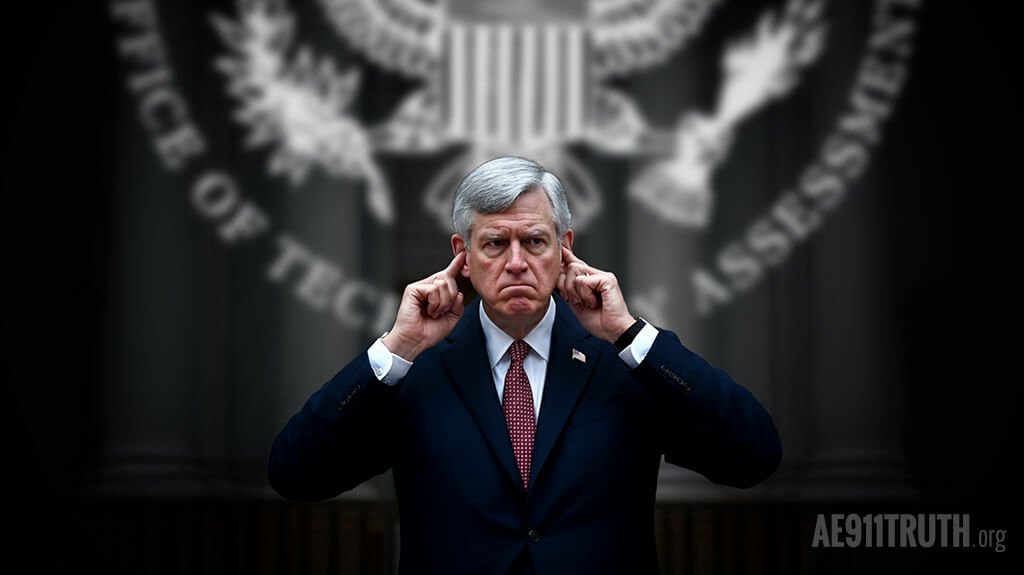Office of Technology Assessment was defunded six years before 9/11
Imagine there was a government agency dedicated to providing members of the U.S. Congress with essential information needed to determine the scientific truth about matters before them.
And imagine such an agency could have provided Congress with information that might have led its members to question what really happened on September 11, 2001. Could this have made a difference? Could it have given Congress a way to evaluate or question information contained in the 9/11 Commission Report? [i]
Such an agency did exist, but its funding was discontinued in 1995, six years before 9/11.
The Office of Technology Assessment (OTA) was created in 1972 (and it received its initial funding in 1974) to provide Congress with scientific information on subjects that directly related to its deliberations. But the OTA came under criticism from some who claimed it duplicated functions carried out by other agencies.
The rationale for the Office was spelled out in the Technology Assessment Act of 1972. It stated that Congress needs to:
- “equip itself with new and effective means for securing competent, unbiased information concerning the physical, biological, economic, social, and political effects of such (technological) applications and;
- “utilize this information, whenever appropriate, as one factor in the legislative assessment of matters pending before the Congress, particularly in those instances where the Federal Government may be called upon to consider support for, or management or regulation of, technological applications."
Among the OTA’s functions were to “provide early indications of the probable beneficial and adverse impacts of the applications of technology and to develop other coordinate information which may assist the Congress.”
Of course, for an agency like the OTA to have helped with 9/11, Congress would have to have been willing to investigate the science of the World Trade Center destruction on its own, without simply waiting for official reports from the National Institute of Standards and Technology (NIST).
And while that willingness almost certainly did not exist two decades ago, that could change with the plan by former Pennsylvania congressman Curt Weldon to ask the incoming Trump administration to convene a presidential task force to investigate 9/11. The initial focus of this project is the evidence that WTC Building 7, which was not hit by a plane, could only have come down with the use of explosives.
Since the OTA was disbanded, there have been other efforts to replace some of its functions. In 2019, for example, the United States Government Accountability Office (GAO) established the Science, Technology Assessment, and Analytics (STAA) team to take on a portion of the technology assessment mission of the former OTA.
In recent years, there have been also calls to re-establish the full agency (beyond just a team within the GAO). For example, Andrew Yang included a proposal to re-create the OTA in his 2020 campaign for the Democratic presidential nomination.

The future of scientific accountability?
Architects & Engineers for 9/11 Truth has initiated a project that could return (or should we say introduce?) scientific accountability to government. Called the Scientific Integrity Act, this proposed legislation would make government agencies accountable for the scientific information in their reports. It would require agencies like NIST to not only address false information in their reports but also to correct it.
One thing that exposed the need for such legislation was the “request for correction” filed with NIST by AE911Truth and a number of 9/11 family members in 2020. It demanded that false claims and inaccurate data in NIST’s 2008 report on the destruction of Building 7 be corrected. This would also compel NIST to reverse its conclusion that fires were the cause of the building’s collapse.
NIST has refused to even address the substance of this request in any substantial way.
As AE911Truth chairman Roland Angle has explained, the Scientific Integrity Act would affect NIST and its blatantly false report in the following ways:
- NIST would be required to correct the computer models used in its analyses to reflect the actual conditions in the structural frame [of Building 7].
- NIST would be required to correct its calculations to reflect the actual known properties of steel acting under a thermal load.
- NIST would be required to correct its incorrect calculations regarding its claim that a cascade of floor failures would have resulted in the northeast corner of the building that they alleged was initiated by the supposed collapse of the northeast corner of the 13th floor.
- NIST would be required to provide a corrected global collapse analysis based upon the changes caused by the above three corrections.
The Scientific Integrity Act would go far beyond the OTA because it would compel government agencies to correct government scientific reports that prove to be false or inaccurate. It would also give citizens legal standing to challenge the validity of reports.
But even if this legislation is passed, it could still be valuable for Congress to have an agency like the OTA that it can go to for factual and accurate scientific information.
It couldn’t do worse than NIST has.
***
Craig McKee is a writer for Architects & Engineers for 9/11 Truth and the creator of the blogs Truth and Shadows and Thought Crimes and Misdemeanors. He also hosts the Truth and Shadows podcast on YouTube and Rumble.
1 (Note: AE911Truth’s research more specifically refutes later technical reports by the National Institute of Standards and Technology (NIST), but we make the assumption that Congress would not likely have used one government scientific agency (OTA) to re-examine the findings of another (NIST, which is an agency within the U.S. Department of Commerce.)




